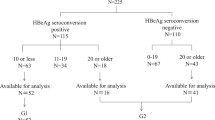Abstract
Human leukocyte antigen (HLA)-F has been involved in immune regulation of infectious diseases. However, the role of HLA-F polymorphisms in hepatitis B infection outcomes remains unclear. Here, we aimed to determine HLA-F polymorphism implication in chronic HBV. Genotype analysis was performed for three single nucleotide polymorphisms (SNPs) of HLA-F and one SNP of HLA-E using PCR-SSP, in 252 Tunisian patients with chronic HBV infection stratified according to their HBV DNA levels (140 patients with low HBV DNA levels < 2000 IU/mL and 112 patients with high HBV DNA levels ≥ 2000 IU/mL) and 240 healthy controls (CTRL). The three HLA-F SNPs (HLA-F*01:02, -F*01:03 and -F*01:04) have the same allelic and genotypic frequencies in patients and in CTRL. We reported a low HLA-F*01:02 and F*01:04 allelic frequencies in the Tunisian population; however, high HLA-F*01:03 allele frequencies were observed (17%). A significant association was found between the HLA-F*01:03 allele and decreased level of HBV DNA (P = 0.02 OR 0.56, 95% CI 0.35–0.92). No significant differences were observed in haplotype distribution between patients and CTRL. A significant association of HLA-F*01:03 with the level of HBV DNA suggests an important role of HLA-F in HBV replication control.
Similar content being viewed by others
References
Lee C-M et al (1999) Age, gender, and local geographic variations of viral etiology of hepatocellular carcinoma in a hyperendemic area for hepatitis B virus infection Cancer 86: 1143–1150. https://doi.org/10.1002/(SICI)1097-0142(19991001)86:7<1143::AID-CNCR7>3.0.CO;2-Z
Baricordi OR, Stignani M, Melchiorri L, Rizzo R (2008) HLA-G and inflammatory diseases. Inflamm Allergy Drug Targets 7:67–74
Braud VM et al (1998) HLA-E binds to natural killer cell receptors CD94/NKG2A. B C Nat 391:795–799
Carosella ED, HoWangYin KY, Favier B, LeMaoult J (2008) HLA-G-dependent suppressor cells: diverse by nature, function, and significance. Hum Immunol 69:700–707
Chapman SJ, Hill AV (2012) Human genetic susceptibility to infectious disease. Nat Rev Genet 13:175–188
Chisari FV, Ferrari C (1995) Hepatitis B virus immunopathogenesis. Annu Rev Immunol 13:29–60
Ganem D, Prince AM (2004) Hepatitis B virus infection–natural history and clinical consequences. N Engl J Med 350:1118–1129
Geraghty DE, Koller BH, Orr HT (1987) A human major histocompatibility complex class I gene that encodes a protein with a shortened cytoplasmic segment. Proc Natl Acad Sci USA 84:9145–9149
Howcroft T, Singer D (2003) Expression of nonclassical MHC class Ib genes: comparison of regulatory elements. Immunol Res 27:1–30
Leone P, Shin EC, Perosa F, Vacca A, Dammacco F, Racanelli V (2013) MHC class I antigen processing and presenting machinery: organization, function, and defects in tumor cells. J Natl Cancer Inst 105:1172–1187
Lepin EJ et al (2000) Functional characterization of HLA-F and binding of HLA-F tetramers to ILT2 and ILT4 receptors. Eur J Immunol 30:3552–3561
Ludajic K et al (2009) Association of HLA-E polymorphism with the outcome of hematopoietic stem-cell transplantation with unrelated donors. Transplantation 88(10):1227–1228. https://doi.org/10.1097/tp.0b013e3181bbb8fe
Moscoso J, Serrano-Vela JI, Arnaiz-Villena A (2007) MHC-F polymorphism and evolution. Tissue Antigens 1:136–139
Pan FH, Liu XX, Tian W (2013) Characterization of HLA-F polymorphism in four distinct populations in Mainland China. Int J Immunogenet 40:369–376
Penna A et al (1991) Cytotoxic T lymphocytes recognize an HLA-A2-restricted epitope within the hepatitis B virus nucleocapsid antigen. J Exp Med 174:1565–1570
Rizzo R et al (2013) HLA-G may predict the disease course in patients with early rheumatoid arthritis. Hum Immunol 74:425–432
Robinson J, Halliwell JA, McWilliam H, Lopez R, Parham P, Marsh SG (2013) The IMGT/HLA database. Nucleic Acids Res 41:17
Strong RK, Holmes MA, Li P, Braun L, Lee N, Geraghty DE (2003) HLA-E allelic variants. Correlating differential expression, peptide affinities, crystal structures, and thermal stabilities. J Biol Chem 278:5082–5090
Tamouza R et al (2005) Association of HLA-E polymorphism with severe bacterial infection and early transplant-related mortality in matched unrelated bone marrow transplantation. Transplantation 80:140–144
Tan AT, Koh S, Goh V, Bertoletti A (2008) Understanding the immunopathogenesis of chronic hepatitis B virus: an Asian prospective. J Gastroenterol Hepatol 23:833–843
Thursz M, Yee L, Khakoo S (2011) Understanding the host genetics of chronic hepatitis B and C. Semin Liver Dis 31:115–127
Wieland S, Thimme R, Purcell RH, Chisari FV (2004) Genomic analysis of the host response to hepatitis B virus infection. Proc Natl Acad Sci USA 101:6669–6674
World H, Organization (2015) Hepatitis B., World Health Organization Fact Sheet 204 (Revised July 2015)
Xu Y, Han H, Zhang F, Lv S, Li Z, Fang Z (2015) Lesion human leukocyte antigen-F expression is associated with a poor prognosis in patients with hepatocellular carcinoma. Oncol Lett 9:300–304
Zhang J, Pan L, Chen L, Feng X, Zhou L, Zheng S (2012) Non-classical MHC-Iota genes in chronic hepatitis B and hepatocellular carcinoma. Immunogenetics 64:251–258
Zidi I et al (2015) Association between sHLA-G and HLA-G 14-bp deletion/insertion polymorphism in Crohn’s disease. Int Immunol 27:289–296
Zidi I et al (2016) HLA-E polymorphism and soluble HLA-E plasma levels in chronic hepatitis B patients Hla 87:153–159
Author information
Authors and Affiliations
Corresponding author
Ethics declarations
Conflict of interest
The authors declare that there are no conflicts of interests.
Rights and permissions
About this article
Cite this article
Laaribi, A.B., Hannachi, N., Ben Yahia, H. et al. Human leukocyte antigen (HLA-F) polymorphism is associated with chronic HBV infection. 3 Biotech 8, 49 (2018). https://doi.org/10.1007/s13205-017-1079-9
Received:
Accepted:
Published:
DOI: https://doi.org/10.1007/s13205-017-1079-9




